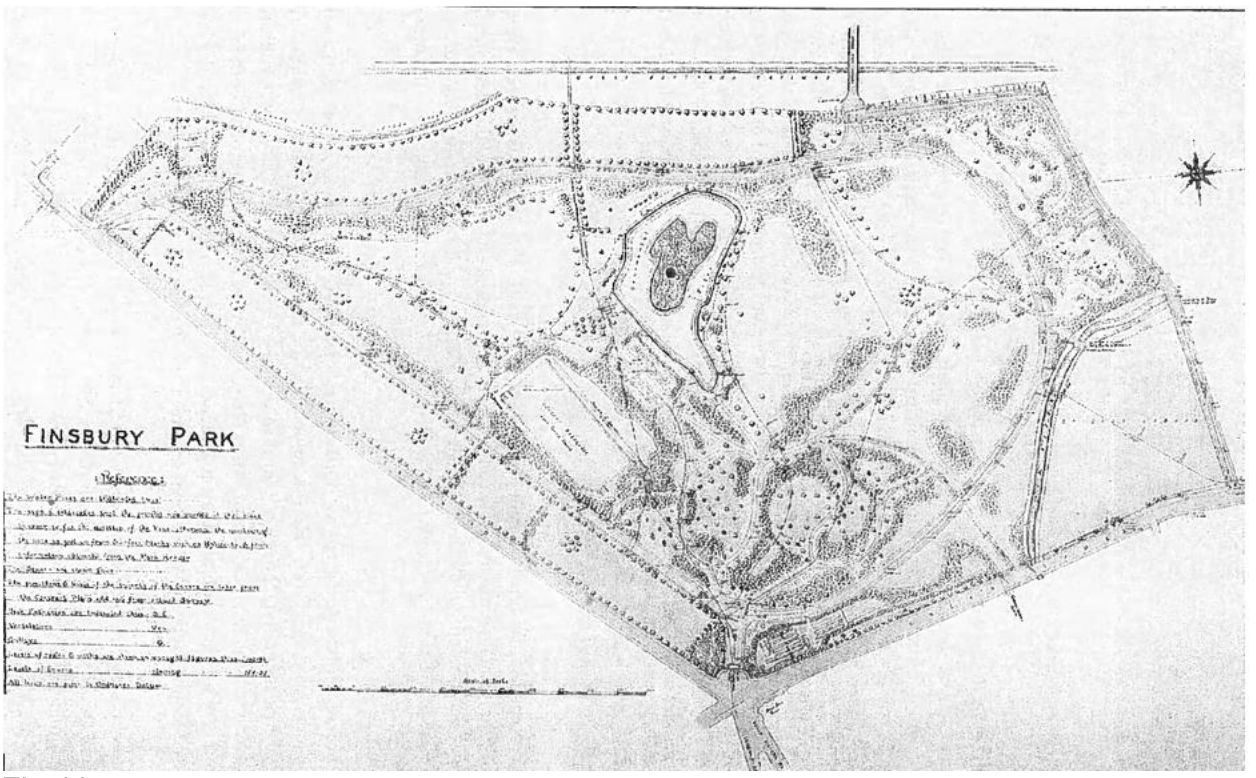
Park history
-
1700s
Records indicate that in the mid-sixteenth century the land now known as Finsbury Park was part of a large woodland estate called Brownswood, the hunting ground of the Bishops of London. Copt Hall manor house stood within the large estate and in 1750 changed its name to Hornsey Wood House, becoming a popular tea house and pleasure gardens.
By 1796 the woodland had shrunk considerably to an area of about 27 acres and the lake we know today was built. The island at the centre of the lake had a causeway across which a farmer was able to herd his livestock, and a small hut provided shelter. -
1800s
In the 1860s Hornsey Wood House was demolished allowing for the expansion of the pleasure grounds – a popular destination right up until the mid-nineteenth century. Finsbury Park as we know it was opened on 9 August 1869 after nearly thirty years of petitioning and political manoeuvring from various local groups and individuals, with Frederick Manable being the driving force. The original goal had been to establish a Royal Park for the north of London similar to Regents Park, Battersea Park and Victoria Park.
Finsbury Park was the first municipal park to be authorised by its own Act of Parliament (1857) and only the second to be laid out in London by the recently established Metropolitan Board of Works (MBW).
The Victorians were great park builders with a firm belief in the social and health benefits provided by recreational public open spaces, values that are still espoused today. The Finsbury Park development was set against the now familiar backdrop of safeguarding open space for public recreation in the face of rapid building development and escalating land values.
Compulsory purchase of land by MBW began in 1864. The present boundaries, Seven Sisters Road, Green Lanes and the railway line (formerly Great Northern), remain more or less the same today as when the Park was opened, and enclose a total area of 46 hectares (115 acres).
Landscape Designer Alexander McKenzie produced the plans for the Park, that were approved in 1868. At the time he was the landscape designer for MBW and had previously designed and supervised work at Southwark Park and Victoria & Albert Embankment Gardens. The whole Park landscape, in the McKenzie style, has an expansive, sweeping aspect that conversely projects an image of formal open space.
Although the Park opened in 1869, construction work continued well into the 1890’s. Early features included a bandstand, refreshment rooms, cricket pavilion, chrysanthemum house, flower gardens and a rosary. At this time the Park was characterised by large open swathes of grass, informal shrub beds, broad tree-lined carriageways and a network of footpaths meandering around the site.
In 1889 management of the Park passed to London County Council (LCC) which replaced MBW. The Ordinance Survey map of 1936 records significant changes to the Park's layout such as the development of an athletics track, tennis courts, and new putting greens. These developments reflected the trend of the time away from passive recreation. Horticultural features changed too as new tree and shrub planting moved away from the original design. -
1900s
In 1949 a children’s playground was constructed alongside the western carriageway. The character of the Park changed dramatically again when the Greater London Council (GLC) inherited responsibility from LCC in 1965. The open air theatre, conservatory and boathouse were demolished and replaced by new public toilets, a football pavilion and ‘The Pit’ play space.
With the demise of the GLC in 1986, management of the Park passed to the London Borough of Haringey.
The period from the 1970's to mid 80's was a period of budgetary constraint within local government nationally, and the Park visibly deteriorated due to the lack of capital investment. The situation was made worse by a widespread growth in vandalism, since funds for many repairs were simply not available. As a result many of the park's notable features disappeared and those that remained, such as the lake and the carriageways, were poor shadows of their former selves.
In an effort to reverse this trend, the Council approached the Heritage Lottery Fund in 1996 to secure capital investment for a programme of improvement works. The bid had a twofold approach, firstly to restore the historic aspect of the landscape and secondly to return the Park to a standard that befits its premier status within the locality. With the aid of several funding bodies, a total of £4.9 million was invested in the restoration project. -
2000s
Completion of these major works was celebrated with a formal ceremony on 6th October 2006; and a tree was planted near the lake and play area to celebrate the completion of the project. The Friends of Finsbury Park obtained funding from Awards for All to research, write and publish ‘A Park for Finsbury’, covering the history and development to date of Finsbury Park and the surrounding area. This book makes a highly valuable contribution to endorsing and promoting the Parks’ heritage and integrity.
Timeline
A Park for Finsbury
Commissioned by The Friends in 2019 to mark its 150th anniversary, A Park for Finsbury is an excellent and comprehensive celebration of the park, researched and written by Hugh Hayes.
Please contact us if you would like to purchase a copy.
